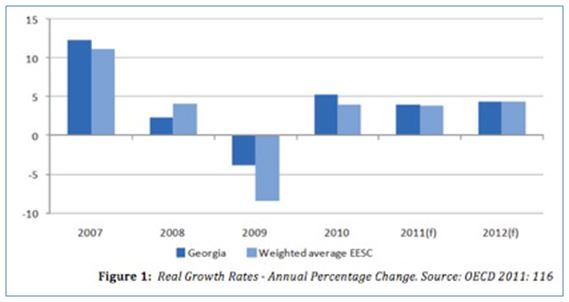Georgia is a small Asian state located at the northern border, separating the Asian and European realms. This country is bordered by Russia in the north, with the Caucasus Mountains acting as a boundary between the two. The state borders both “Armenia and Turkey to the south and Azerbaijan to the east” (Suny 1994:1). This state has a surface area of 69,700 Km2 and enjoys a coastline of approximately 315 kilometers with the Black Sea in the west.
Georgia’s latest official census was taken two-and-a-half decades ago in the year 1989, placing its population index at 5,400,489 people. Nonetheless, the state approximates this population at a figure of 5.4 million people after underestimating the emigration figures. On the other hand, the CIA’s ‘World Factbook’ puts this figure at approximately 4.989 million people as per the statistics of 2001.
With birth rates and mortality rates standing at 1.087% and 1.452% respectively per 1000 people coupled with an emigration rate of 2.57% per 1000 people, Georgia’s population growth rate (-0.62%) exhibits a declining population. This is with respect to the statistics done in the year 2000. This population is a composite of 6 ethnical groups with the Georgians accounting for a larger percentage (70%).
The other minority groups include the “Armenians (8%), Azeris (6%), Russians (6%), Ossetians (3%), and Abkhazians (1.8 %)” (Herzig 1999:12). These groups, however small, they are a menace to the Georgian government. They occur in clusters and hence opt for independence akin to Georgia’s three autonomous republics that include “Abkhazia, Adjara and South Ossetia” (Herzig 1999:12).
Georgia’s economy is supported by a number of industries including mining, tourism, and manufacturing industry. The mining industry represents one of the significant industries in the Georgian economy. Its manganese deposits were once among the richest globally, accounting for approximately 200 million tones. Moreover, the land is endowed with considerable deposits of valuable minerals, including freshwater.
Bottled water production has started peaking after many years of mediocre production post-independence (1993) with Borjormi dominating the market. However, its manufacturing industry is shaky with most factories unable to pay their overhead costs e.g., electricity. With the phobia of redundancy, the government is reluctant to take corrective action. The most lucrative sectors of this industry include the chemical (fertilizers) and metallurgy industries.
Agricultural-based industries accounted for a paltry 4.7% of the GDP in the year 2000, reflecting the state of the economy of this country. Georgia’s tourism industry depicts a sector that lay in ruins and largely underexploited. The initially thriving industry with over 3 million visitors per annum was halted by the 1990s civil war. In the year 1999, this figure had declined to approximately 383,000 people, with many hotels hosting internally displaced people following the secession of Abkhazia.
With an elegant coastline and snow-capped mountain ranges, tourism represents a potential industry that can serve as the backbone of the Georgian economy. Importantly, the financial sector depicts an economy on a decline, with the number of banks decreasing from 294 in 1998 to 33 by the turn of the century.
Georgia was a British colony founded in 1732 by James Oglethorpe, a former British soldier. He was entrusted along with 20 other colonists by the then British king, King Georgia II, to colonize the land stretching from Altamaha to the Savannah region.
This colony was resourceful to the Britons who envisaged it as fertile land for growing mulberry trees vital in supporting the existence of silkworms important for their silk industry back home. Moreover, this colony was vital for protecting the region from the Spanish and French invasion. Of note, this colony served to host British settlers who had massive debts dubbed the ‘worthy poor’ to use the land to redeem themselves.
Georgia is currently affected by the slow pace at which its economy is growing post-2008. The Georgian economy is responding to an aftermath of the Georgian-Russian War. The initially celebrated economy of President Saakashvili’s government has been recording negligible growth post-Georgian-Russian War (see figure below). Apart from this war, the Georgian economy has been affected by other issues which have also had considerable effects on its democratic process.

Initially, the Saakashvili administration embraced deregulation with the aim of boosting the economy of Georgia. With this, the government envisioned an economy that would grow akin to that of Switzerland graced with Singaporean elements. As a consequence, the state recorded high World Bank scores with regards to enhancing a business-oriented climate.
However, this was overshadowed by low indices in the government’s competence in other areas such as “property rights, judicial independence, and protection of minority shareholders’ interests” (Acemoglu and Robinson 2008:12). Against this backdrop, the Georgian economy is unlikely to record significant growth. Factors e.g., corruption at the top level and economic gap have only functioned to complicate the whole situation.
Like it has been stated initially, Georgia is bordered by four nations. Of the four nations, Georgia has strained its relations with Russia. Their hostility stretches way back in 1921 and stems from espionage accusations. Also, with its location between Russia and Turkey, Georgia acts as a buffer zone, preventing the two states from engaging in war. Georgia hosts embassies of its other neighbors portraying a peaceful relation with its neighbors.
References
Acemoglu, D. and Robinson J. 2008. The Role of Institutions in Growth and Development. Commission on Growth and Development Working Paper 10: 1-3.
Herzig, E. 1999. The New Caucasus. London: The Royal Institute of International Affairs.
Suny, R. 1994. The Making of the Georgian Nation. London: Indiana University Press.